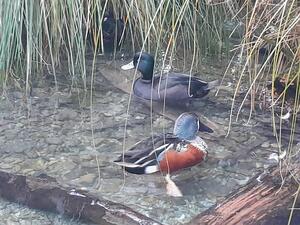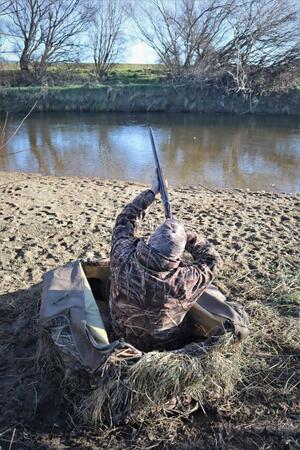Both Barrels June 2023 - Otago
- Otago
- 20/06/2023

Above: As ducks head for larger bodies of water, so should the hunters.
Big water, bigger opportunities.
Heading further into winter, the weather is reminding us that we live in the deep south.
Snowfall, hoar frosts, and short days can make it hard to get up early for a hunt.
But hunters braving the elements can still experience good shooting.
As conditions get colder, many smaller ponds and creeks freeze over. When the birds return in the morning from nightly feeding areas, they’re finding loafing areas frozen solid.
Birds will therefore be congregating in non-frozen areas during the day.
These include:
- Larger water bodies, such as lakes and big irrigation ponds.
- Rivers and other flowing water.
- Warmer, sunny riverbanks.
- Paddocks (especially after flooding)
So, when your favourite pond freezes over, don’t put your shotgun away until next season. There are still other waterways and areas to produce a feed or two.
Shoveler limit
Shovelers are a popular addition to our bag in New Zealand. The stunning plumage, challenging shots and exquisite meat they provide make these a sought-after game bird.

The Otago Region has reduced the daily bag limit for shoveler to only one drake.
Unfortunately, the long-term national count of these birds shows a downward trend.
As a result, Otago Fish & Game Council halved the bag limit from two birds to one per day and limited the harvest to only drakes.
Reduction of hen mortality during the shooting season is one step we can take to help these birds.
Shoveler populations, like many smaller waterfowl, tend to be ‘drake heavy’, with males out-numbering females.
One of the reasons for this is the risk of hens being predated while sitting on the nest.
Unfortunately, Otago Rangers have found a few shot hen shovelers this season. Just a reminder:
- The shoveler daily bag limit in Otago Region is 1 drake.
- Identify your target beyond all doubt.
- If it’s difficult to identify drakes and hens, such as in poor light, don’t take the shot.
Blind good fortune

River shooting from a laydown blind.
Scouting is key. Spend time with a pair of binoculars to find areas where birds are loafing during the day.
This can make all the difference to your next hunt.
Once you know, a portable blind allows you to hunt wherever the birds are.
Weave grass and scrub into the blind to blend with your surroundings.
Portable blinds may be commercially bought or homemade, including:
- Laydown.
- Pop-up.
- Camouflage net.
Trees, scrub, long grass or fallen logs and branches can also be useful for concealment.
Less can be more
As the Otago mallard season continues into next month, try smaller decoy spreads comprising pairs of decoys – a hen and a drake.
A greeting call will likely attract passing drakes hoping to steal a mate.
Keep the paired decoys far enough apart to suggest a group of birds that have partnered up.
Make the most of the season
Otago Region’s abundant and varied resources provide a longer game bird season than other regions, especially in the North Island.
With the Matariki public holiday approaching on July 14, why not invite a mate down from up north for a long weekend and show them what our region has to offer?
Otago game bird season closure dates:
- July 30 ─ grey/mallard/shoveler.
- August 27 ─ black swan (Area B) and paradise shelduck.
- August 27 ─ California quail, chukar, cock pheasant.
Hot barrels and safe hunting,
The Otago Fish & Game team